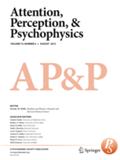
本期特刊的首要目標(biāo)是為實(shí)證和評論論文提供一個專門的空間,以促進(jìn)對認(rèn)知和行動系統(tǒng)如何集成和協(xié)同運(yùn)作的理解。關(guān)于人類如何在復(fù)雜環(huán)境中高效互動和導(dǎo)航的知識對于全面理解人類行為至關(guān)重要,并將有助于塑造日常物品的設(shè)計(jì)、培訓(xùn)和工作環(huán)境。很明顯,我們認(rèn)知過程的產(chǎn)物是通過我們的行為來表達(dá)的。從歷史上看,將感官輸入轉(zhuǎn)化為行動被視為一組相對單向的處理事件,其結(jié)果是低水平的感官和較早的知覺過程通知高階認(rèn)知過程,直到做出響應(yīng)的決策,此時行動系統(tǒng)收到指令。考慮到這種劃分的方法,研究人員在認(rèn)知和運(yùn)動領(lǐng)域的互動相對較少也就不足為奇了。因此,直到最近,對人類行為的更深層次的理解一直受到阻礙,因?yàn)楹苌儆腥岁P(guān)注更廣泛的行動背景,以及行動過程是如何嵌入到更大的視覺注意力、記憶、學(xué)習(xí)、決策和人際互動的畫布上的。我們尋求來自多個領(lǐng)域的研究人員的貢獻(xiàn),包括但不限于,心理學(xué),神經(jīng)科學(xué),運(yùn)動機(jī)能學(xué)和人機(jī)交互,以分享和批判性地評估他們的前沿理論,經(jīng)驗(yàn)和翻譯的發(fā)展。提交的內(nèi)容可以是經(jīng)驗(yàn)文章的形式,報(bào)告來自原始研究的新結(jié)果、有針對性的評論或有趣的觀點(diǎn)。這個特別的問題將有一個廣泛的范圍,包括實(shí)驗(yàn),理論,計(jì)算,臨床研究,以及方法學(xué)的方法。有興趣提交評論或觀點(diǎn)文章的作者,強(qiáng)烈建議在2018年8月1日前向客座編輯提交一份約1頁的預(yù)提交查詢。如果您對可能的投稿有任何疑問,請聯(lián)系我們的客座編輯。所有提交的論文都將經(jīng)過正常的、全面的同行評審,并保持與定期提交的注意力、感知和心理物理學(xué)論文相同的高編輯標(biāo)準(zhǔn)。手稿應(yīng)包括一封封面信,表明提交的是特刊《行動的時間:更好地理解認(rèn)知的動態(tài)》。因?yàn)檫@是期刊特刊,不是編輯過的書,截稿日期是確定的;我們打算在截止日期后6-8個月出版特刊。由客座編輯邀請的修改將在收到編輯決定函和評論后的兩個月內(nèi)進(jìn)行。《注意、知覺與心理物理學(xué)》是心理經(jīng)濟(jì)學(xué)會的官方期刊。它涵蓋了感覺過程、知覺、注意力和心理物理學(xué)的所有研究領(lǐng)域。發(fā)表的文章多為實(shí)驗(yàn)工作報(bào)告;該雜志還提供理論,綜合和評價(jià)的評論。《認(rèn)知與心理物理學(xué)》創(chuàng)刊于1966年,2009年更名為《認(rèn)知與心理物理學(xué)》。該雜志還鼓勵從神經(jīng)科學(xué)的角度進(jìn)行研究,以增強(qiáng)我們對注意力、知覺和心理物理學(xué)的理解。如需與編輯有關(guān)的查詢,請致電mdodd2@unl.edu與主編邁克·多德博士聯(lián)系關(guān)于ScholarOne投稿系統(tǒng)的問題,請聯(lián)系journals@psychonomic.org《注意知覺與心理物理學(xué)》是心理經(jīng)濟(jì)學(xué)會的期刊,致力于在科學(xué)出版和實(shí)踐中堅(jiān)持誠信原則。作為出版?zhèn)惱砦瘑T會(COPE)的成員,該雜志將遵循COPE關(guān)于處理潛在專業(yè)不端行為程序的指導(dǎo)方針。
The overarching goal of this special issue is to provide a dedicated space for empirical and review papers that advance the understanding of how cognition and action systems are integrated and operate synergistically. This knowledge of how humans efficiently interact and navigate in complex environments is vital for generating a comprehensive understanding of human behavior and will help shape the design of everyday objects and training and working environments. It is evident that the products of our cognitive processes are expressed through our actions. Historically, the transformation of sensory inputs into action has been treated as a set of relatively unidirectional processing events with the results of low-level sensory and earlier perceptual processes informing higher-order cognitive processes until a decision is made to respond, at which point the action system receives its instructions. Given this compartmentalized approach, it may not be too surprising that there has been relatively little interaction between researchers in cognitive and motor domains. Thus, until recently, a deeper understanding of human behavior has been hindered because little attention has been paid to the broader context of action and how action processes are embedded in the larger canvas of visual attention, memory, learning, decision-making and interpersonal interaction. We seek contributions from researchers across multiple areas, including but not limited to, psychology, neuroscience, kinesiology, and human-computer interactions, to share and critically evaluate their cutting-edge theoretical, empirical, and translational developments. Submissions could be in the format of empirical pieces reporting new results from original research, targeted reviews, or interesting viewpoints. The special issue will have a broad scope encompassing experimental, theoretical, computational, and clinical studies, as well as methodological approaches. Authors who are interested in submitting a review or viewpoint paper are highly recommend to submit a pre-submission inquiry of approximately 1 page to the guest editors by August 1, 2018. If you have any question about a possible submission, please contact one of the guest editors.All submissions will undergo normal, full peer review, maintaining the same high editorial standards for regular submissions to Attention, Perception, & Psychophysics. Manuscripts should include a cover letter indicating that the submission is for the special issue, “Time for Action: Reaching for a better understanding of the dynamics of cognition”.Because this is a journal special issue, not an edited book, the deadline is firm; our intention is to publish the special issue 6-8 months after the submission deadline. Revisions invited by the guest editors will be expected within two months of receipt of the editorial decision letter and reviews.The journal Attention, Perception, & Psychophysics is an official journal of the Psychonomic Society. It spans all areas of research in sensory processes, perception, attention, and psychophysics. Most articles published are reports of experimental work; the journal also presents theoretical, integrative, and evaluative reviews. Founded in 1966 as Perception & Psychophysics, the journal assumed its present name in 2009.The journal also encourages studies with a neuroscientific perspective that enhance our understanding of attention, perception, and psychophysics. For editorial-related inquiries, please contact Editor-in-Chief Mike Dodd, Ph.D, at mdodd2@unl.edu For questions concerning ScholarOne's manuscript submission system, please contact journals@psychonomic.orgAttention Perception & Psychophysics , a journal of The Psychonomic Society, is committed to upholding principles of integrity in scientific publishing and practice. As a member of the Committee on Publication Ethics (COPE), the journal will follow COPE guidelines concerning procedures for handling potential acts of professional misconduct.
SCI熱門推薦期刊 >
SCI常見問題 >
職稱論文常見問題 >
EI常見問題 >